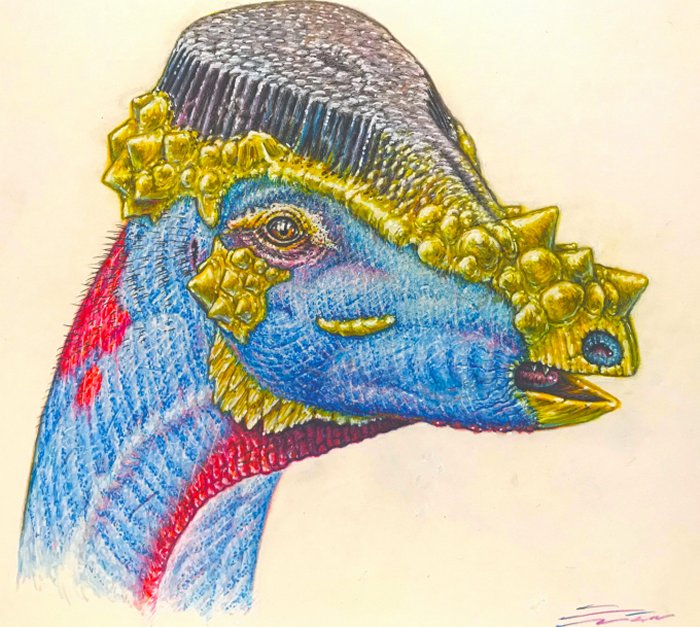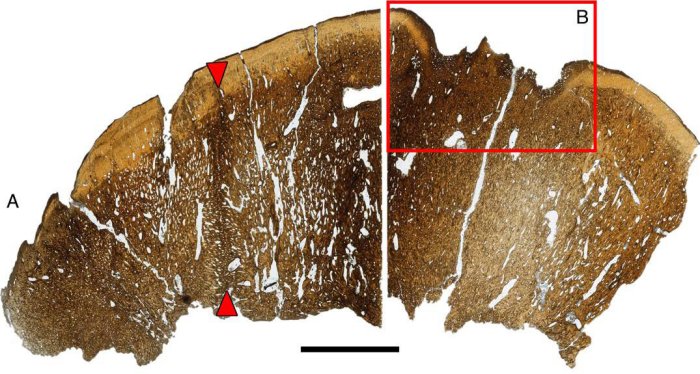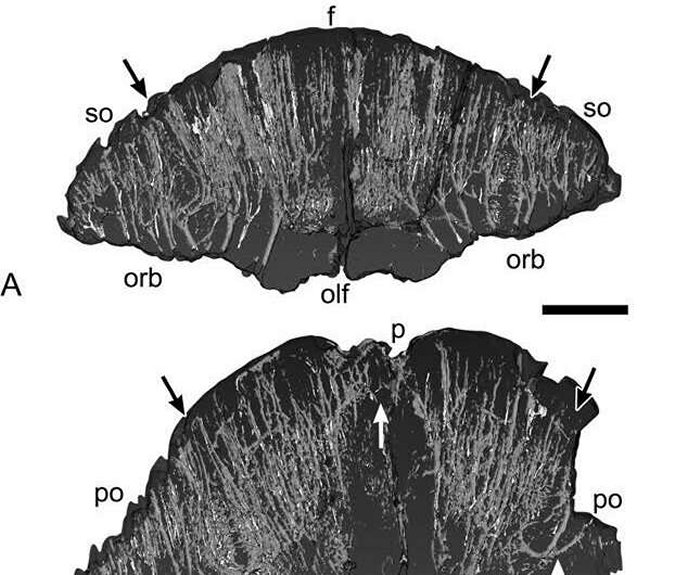Conny Waters – AncientPages.com – If you look at enough dinosaur fossils, you’ll see that their skulls sport an amazing variety of bony ornaments, ranging from the horns of Triceratops and the mohawk-like crests of hadrosaurs to the bumps and knobs covering the head of Tyrannosaurus rex.

An artist’s depiction of a newly described species of pachycephalosaur that was named Platytholus clemensi, after the late UC Berkeley paleontologist William Clemens. The skull is dome-shaped, but UC Berkeley and Chapman University paleontologists believe it was covered with bristles of keratin (purple) that may have been even more elaborate than depicted here. The bony knobs and spikes (yellow) are characteristic of pachycephalosaurs and many other dinosaurs. Credit: Jack Horner
But paleontologists are increasingly finding evidence that dinosaurs had even more elaborate head ornaments not preserved with the fossil skulls—structures made of keratin, the stuff of fingernails, that were likely used as visual signals or semaphores to others of their kind.
A newly described species of dome-headed dinosaur—a pachycephalosaur dating from around 68 million years ago—is the latest example. Pachycephalosaurs lived during the Cretaceous period, between about 130 and 66 million years ago, and tended to be small-to-medium-sized plant eaters. Ranging from 3 to 15 feet long, they walked on two legs and had a long, stiff tail for balance.
The new species is based on a partial pachycephalosaur skull, including its bowling-ball shaped dome, that was unearthed in 2011 in the Hell Creek Formation in Montana, which are layers of Upper Cretaceous rock from which paleontologists have collected dinosaur fossils for decades.
Based on CT scans and microscopic analyses of slices through the fossilized dome, paleontologists Mark Goodwin of the University of California, Berkeley, and John “Jack” Horner of Chapman University in Orange, California, concluded that the skull likely had sported bristles of keratin, reminiscent of a brush cut.
“We don’t know the exact shape of what was covering the dome, but it had this vertical component that we interpret as covered with keratin,” Goodwin said, noting that a bristly, flat-topped covering “biologically makes sense. Animals change or use certain features, particularly on the skull, for multiple functions—it could be for display or for social and biological interactions involving visual communication.”
“I would guess that there was something pretty elaborate up there,” said Horner, a lecturer and presidential fellow at Chapman, professor emeritus at Montana State University in Bozeman and emeritus curator at the Museum of the Rockies.
Peculiarly, the skull had a nasty gouge at the apex that had healed, indicating that a serious accident once befell the creature, but that it had survived long enough for new bone tissue to grow into the gash.
“We see probably the first unequivocal evidence of trauma in the head of any pachycephalosaur, where the bone was actually ejected from the dome somehow and healed partially in life,” said Goodwin, emeritus ᴀssistant director and paleontologist at the UC Museum of Paleontology. “We don’t know how that was caused. It could be head-ʙuттing—we don’t dispute that.”

A histological thin section of the bony domed skull of the newly described pachycephalosaur. The area of injury, fracture and partially healed bone on the top of the dome is shown by the red rectangle. (The scale bar is 2 centimeters). Credit: Jack Horner and Mark Goodwin
Goodwin and Horner caution that this head lesion, about a half-inch deep, is not a smoking gun for the storied hypothesis that these dinosaurs ʙuттed heads as part of their social interactions—the Cretaceous equivalent of the way bighorn rams clash heads today. Instead, the injury could have been caused by anything from a falling rock to a chance encounter with a tree or another dinosaur.
“That’s the first place everybody wants to go—let’s crash them together. And, you know, we just don’t see any evidence of it, histologically,” Horner said, referring to detailed studies of the tissues underlying the dome, both in this specimen and in other pachycephalosaur skulls. “Something hit the top of this guy’s head and damaged it, and it was something that was severe. But having a defense mechanism on your head is not a good idea, not for anybody. Any features, any accouterments that we find on the heads of dinosaurs, I think, are all display—it’s all about display.”
Such ornamentation is common in the reptile ancestors of dinosaurs and their bird descendants; they’re used both to attract mates and intimidate rivals. But Horner and Goodwin have long argued that the internal structure of pachycephalosaur skulls is not cushiony enough to allow head-ʙuттing without severe brain damage, and that head-ʙuттing is a mammal thing that is rarely seen in reptiles or birds. Specifically, pachycephalosaur skulls lack specializations, such as a pneumatic chamber above the braincase, as found in bighorn sheep, or other features present in mammals that engage in violent head-ʙuттing behavior.
“I don’t see any reason to turn dinosaurs into mammals, rather than just trying to figure out what they might be doing as bird-like reptiles,” Horner said.
Horner, Goodwin and David Evans of the University of Toronto and the Royal Ontario Museum in Canada published their description of the new pachycephalosaur last month in the Journal of Vertebrate Paleontology. The team named the new species Platytholus clemensi, after the late UC Berkeley paleontologist William Clemens, who collected many fossils—in particular mammalian fossils—in the same Hell Creek Formation where the new species was found.
‘A bowling ball in the fossil record’
According to Horner and Goodwin, pachycephalosaur skulls are quite common in many dinosaur beds, though somewhat less so in the Hell Creek Formation, which dates from the late Cretaceous Period, a few million years before the asteroid or comet impact that lowered the curtain on dinosaurs and changed the trajectory of life on Earth. One primary reason for the skulls’ ubiquity is the large bony dome.
“With pachycephalosaurs, think about a bowling ball in the fossil record,” Goodwin said. “Their skulls roll around, get buried, and when exposed on the surface, they’re very robust, so they can withstand a lot of weathering and erosion sitting out there. More than once, people have walked over an area all summer and discovered that what they thought was just a rock, because it looks like a glacial cobble, turned out to be a really nice dome.”

A CT scan of the dome reveals the well-organized vertical arrangement of the neurovascular network in the skull and dome of Platytholus clemensi, suggesting that the network fed verticle structures on top of the dome. (Scale bar is 2 centimeters). Credit: Jack Horner and Mark Goodwin
Though Goodwin and Horner have unearthed many other fossils from the Hell Creek Formation over the past 45 to 50 years, including bones of Triceratops, T. rex and duckbilled hadrosaurs, they have a particular interest in pachycephalosaurs—both their evolution and their development from juvenile to adult. They’ve sliced through many skulls to study how they change over time and to test the theory that the creatures ʙuттed heads with one another, or at least, that the males did.
Their conclusion: There’s no evidence, based on bone structure, that the skull or neck could withstand a head-to-head collision. The newly described partial skull, which was not found with other parts of the skeleton, also has a bone structure inconsistent with head-ʙuттing.
Because the skull bones didn’t look like specimens from any of the other two types of juvenile, sub-adult or adult pachycephalosaurs that lived in the area around the same time—Pachycephalosaurus itself, after which these dinosaurs are named, and Sphaerotholus—the paleontologists classified the animal as a new genus and species, Platytholus clemensi.
The skull did have characteristics that the paleontologists had seen in other pachycephalosaurs, including Sphaerotholus: blood vessels in the skull that ended abruptly at the surface of the dome, indicating that the blood originally fed some tissue that was sitting atop the dome. If that covering were a sheath of keratin, the blood vessels would have spread out and left indentations or grooves along the domed surface, as seen, for example, under the beaks of birds or on the skulls of Triceratops and other ceratopsians or horned dinosaurs. But the vessels were perpendicular to the surface, as if they fed a vertical structure.
“What we see are these vertical canals coming to the surface, which suggests that there might be keratin on top, but it’s oriented vertically,” said Horner. “I think these pachycephalosaurs had something on top of their head that we don’t know about. I don’t think they were just domes. I think there was some elaborate display on top of their head.”
Goodwin noted that the shape of the domed heads of pachycephalosaurs changed as the animals matured, becoming more prominent and elaborate as they approached adulthood. That, too, would suggest they were used for Sєxual display and courting, though they may have been used to ʙuтт the flanks, as opposed to the heads, of male rivals. He suspects that dinosaurs likely distinguished gender by color, as do most modern birds, such as cᴀssowaries, peafowls and toucans, which have bright integumental colors around the face and head for visual communication.
“It’s reasonable to suggest that the covering over the dome may also have been brightly colored or subject to color change seasonally,” he said.
The paleontologists are obtaining CT scans and doing thin-section histology of other pachycephalosaur domes to determine whether other dome-headed dinosaurs may have displayed elaborate vertical headgear in addition to the known array of bumps, nodes and horns.
“The combination of cranial histology after thin-sectioning the skull and CT scanning gave us a much richer body of data and forms a basis for our hypothesis that there was a keratinous covering over the dome,” Goodwin said. “We know the dome was covered with something, and we make a hypothesis, at least in this taxon, that it had a vertical structural component, unlike Triceratops, T. rex and other dinosaurs, which had hard skin or keratin closely covering the bone.”
Goodwin and Horner named the new species after Clemens because both developed close ties to him over the many summers all three explored Montana in search of Cretaceous fossils, sometimes working side by side in the field.
“Bill Clemens was a very important person in Mark’s life, but he may have been more important in my life because he was the person who, back in 1978, said, ‘You know, Jack, there’s this woman in Bynum, Montana, who found a large dinosaur, and she needs it identified,'” Horner said. When he and colleague Bob Makela checked out the woman’s rock shop, Horner said, she asked about a few smaller fossils in her shop, too, which turned out to be “the first baby dinosaur bones found in the world.”
That discovery provided the first clear evidence that some dinosaurs cared for their young and led Horner to write several books about family structure among duckbilled dinosaurs, including “Digging Dinosaurs” in 1988 and a sequel, “Dinosaur Lives: Unearthing an Evolutionary Saga,” in 1997. He also wrote several children’s books, including “Maia: A Dinosaur Grows Up,” in 1995, about a baby duckbill of the species Horner named Maiasaura, and the 2023 sequel, “Lily and Maia….a Dinosaur Adventure.”
“I owe a great amount of graтιтude to Bill Clemens for sending me on that little trip,” said Horner.
Written by Conny Waters – AncientPages.com Staff Writer





